The Queen and Martin McGuinness' four-second handshake
- Published
BBC News NI's Gareth Gordon looks back at the Queen's relationship with Northern Ireland
Royalty in the 21st Century is more about symbolism than power, but the Queen knew the power of symbols in the cause of reconciliation.
In June 2012, she greeted thousands at Stormont for a Diamond Jubilee party.
Earlier the eyes of the world focused on an historic handshake with Martin McGuinness at Belfast's Lyric theatre.
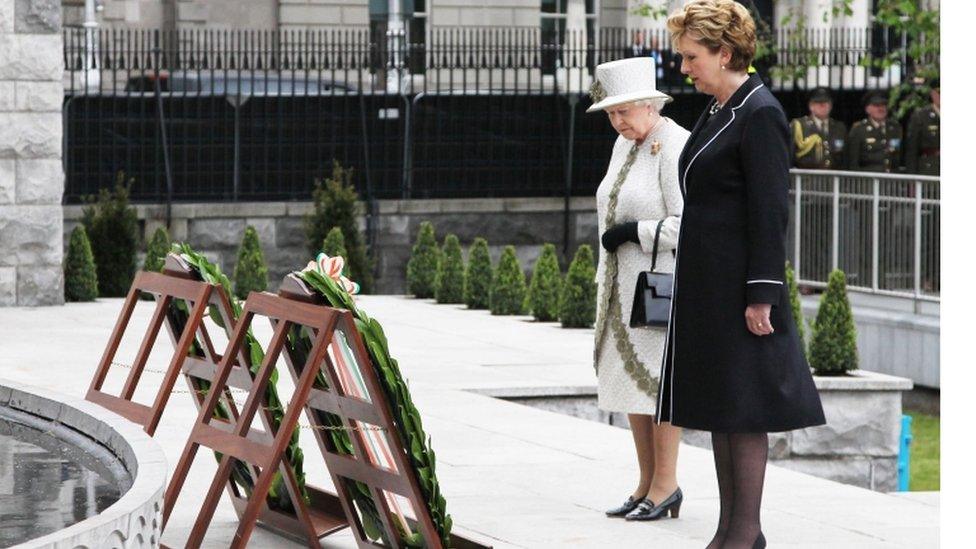
The Queen and the then Irish President, Mary McAleese, laid wreaths at the Garden of Remembrance in Dublin in May 2011
The four-second handshake between the former IRA leader and the British monarch appeared to usher in a new era in 40 years of troubled history.
A year earlier, the Queen had broken new ground in Dublin, joining the then Irish President, Mary McAleese, to lay wreaths at the Garden of Remembrance.

Queen Elizabeth at the National Convention Centre, Dublin, in 2011
Given that the garden is dedicated to those who died fighting British rule, this was another occasion that, at one time, would have seemed unimaginable.
Then the Queen went on to charm her Irish audience at a state banquet when she spoke in Irish, greeting them: "A Uachtaráin agus a chairde" (president and friends).
There were some small, republican protests, but during a visit to the English market in Cork, most people seemed more than ready to welcome the Queen on the first visit to the Republic of Ireland by a British monarch since King George V in 1911.
If these scenes were a novelty in Cork, not so north of the border where the Queen was a frequent visitor over the decades.

The Queen and the Duke Of Edinburgh arrived by steam train to open the new Bellarena Station village in County Londonderry in 2016
In fact, she took her first flight in an aircraft in 1945 when, as a teenage princess, she accompanied her parents to Northern Ireland on a two-day visit.
Four years later, Princess Elizabeth was back, together with her husband, Prince Philip.
The couple returned in 1953 after the Queen's coronation.
Inevitably, given the politics of Ireland, not everyone was a fan. In 1966, the Queen opened a new bridge across the River Lagan in Belfast named in her honour. But as her motorcade wound through the city, a protester dropped a brick from a high building onto the bonnet of the Royal car.
When the Queen celebrated her Silver Jubilee in 1977, the Troubles were at their height. The IRA threatened to give the monarch a "visit to remember".
Spectators lined the shores of Belfast Lough to watch the Queen arrive on board the Royal Yacht Britannia. She made a special reference to Northern Ireland in her Christmas message that year.
"No-where is reconciliation more desperately needed than in Northern Ireland," she said.
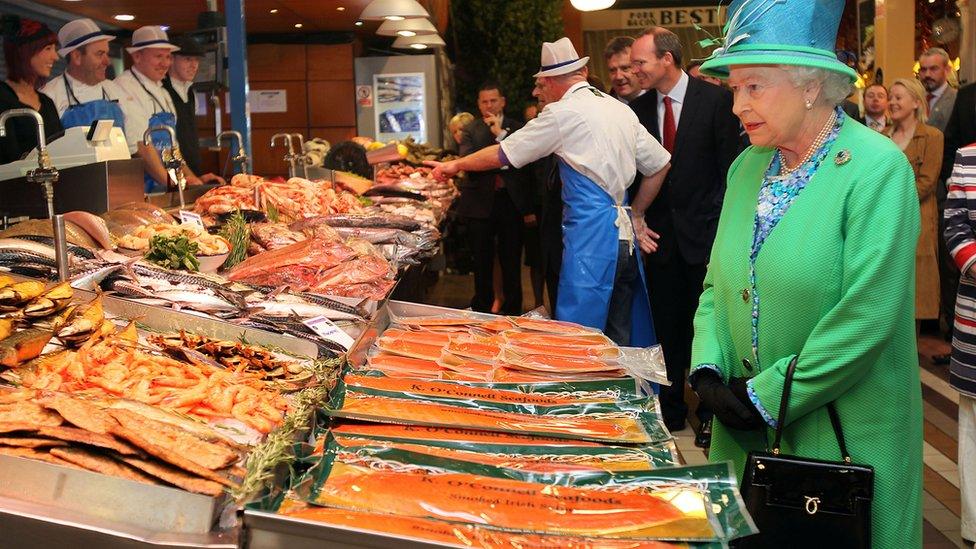
The Queen visited Pat O'Connell's fish stall at the English Market in Cork in 2011
"That is why I was particularly pleased to go there. No-one dared to promise an early end to the Troubles but there is no doubt that people of goodwill in Northern Ireland were greatly heartened by the chance they had to share the celebrations with the rest of the nation and Commonwealth."
She often expressed sadness after atrocities committed during the Troubles. But the murder that hurt her most personally had to be the IRA's assassination of Earl Mountbatten, in 1979.
The earl was her husband's uncle. She appeared to refer implicitly to his loss many years later in her Dublin speech.
"It is a sad and regrettable reality that through history our islands have experienced more than their fair share of heartache, turbulence and loss," she said.
"These events have touched us all, many of us personally, and are a painful legacy. We can never forget those who have died or been injured, and their families.
"To all those who have suffered as a consequence of our troubled past I extend my sincere thoughts and deep sympathy.
"With the benefit of historical hindsight we can all see things which we would wish had been done differently or not at all."

The then Northern Ireland Secretary John Reid showed the Queen the site of the 1998 Real IRA bombing in Omagh, as part of the Golden Jubilee Tour in 2002
As the Troubles raged, the Queen did not visit Northern Ireland at all during the 1980s.
But she returned in the 1990s - praising the Ulster Defence Regiment in Lisburn, opening another new bridge in Belfast and meeting church leaders in Armagh.


In 2000, she presented the Royal Ulster Constabulary with the George Cross, then later that decade watched dance and drama in Londonderry, and toured the site of the Omagh bombing, external.
At Stormont, she praised the progress made towards peace.
"Life has never been straightforward here, but I welcome the real sense of normality that has, over recent years, been returning to the lives of ordinary people, even if tempered from time to time by moments of disappointment and pessimism. You now have a better future for Northern Ireland in your grasp," she told politicians.
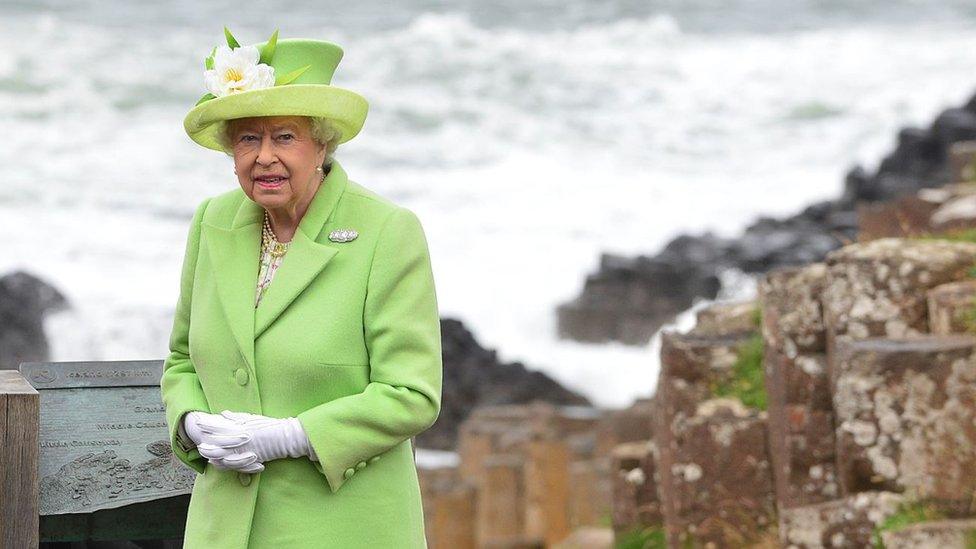
The Queen's trip to the Giant's Causeway in 2016 was her first visit to Northern Ireland's best known tourist attraction
Her last visit to Northern Ireland ended up being in 2016 - she had been due to visit Northern Ireland for a two-day trip in October 2021 to coincide with the centenary but it was cancelled on medical advice.
This was perhaps when the public first became aware of concerns surrounding the then 95-year-old's health.
Throughout her reign, the Queen remained painfully aware of the tragedies that beset Northern Ireland.
But she seemed to take heart from the knowledge that she could play an important role in helping people put the past in perspective and concentrating minds on what she hoped would be a brighter future.
- Published9 September 2022
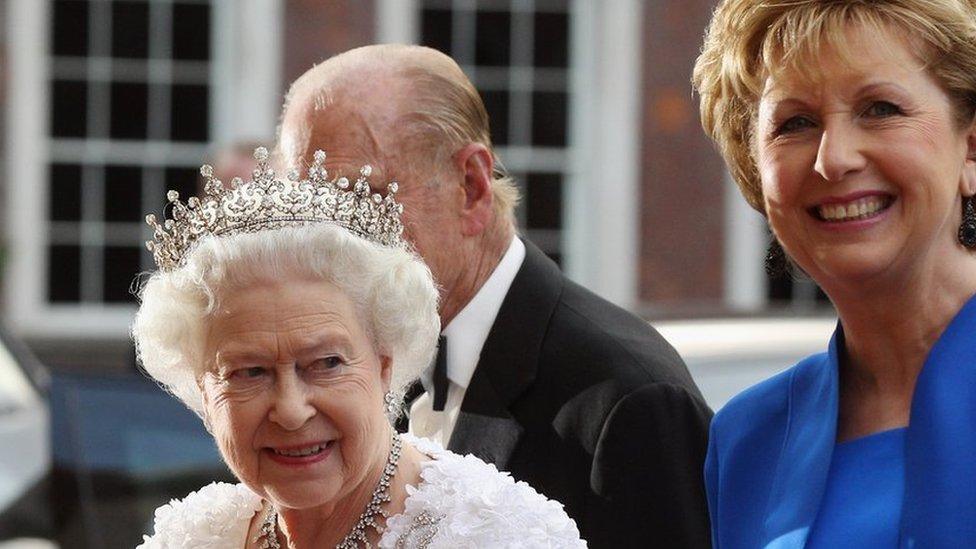
- Published9 September 2022
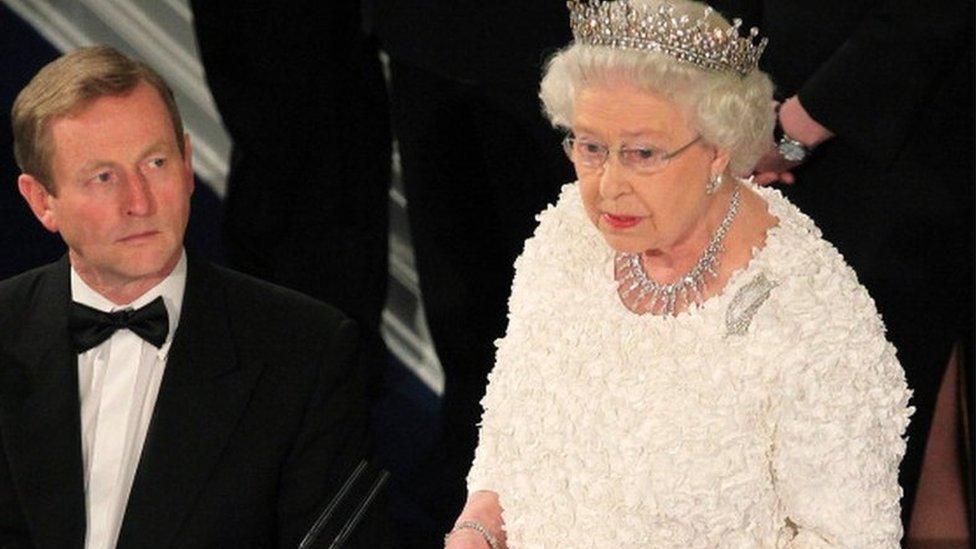
- Published8 September 2022
